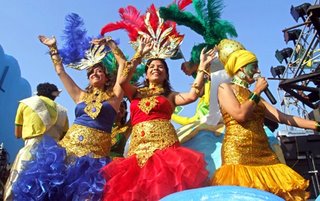 Carnival in Goa was a great leveler. Early accounts-all of them hearsay-are indeed educative. The white masters masqueraded as black slaves and the latter-generally slaves brought in from Mozambique-plastered their faces with flour and wore high battens, or walked on stilts. For those three ephemeral days, they were happy to be larger than life. And while the whites and the blacks mimicked each other the brown locals watched this reversal of roles in awe from the sidelines.
Carnival in Goa was a great leveler. Early accounts-all of them hearsay-are indeed educative. The white masters masqueraded as black slaves and the latter-generally slaves brought in from Mozambique-plastered their faces with flour and wore high battens, or walked on stilts. For those three ephemeral days, they were happy to be larger than life. And while the whites and the blacks mimicked each other the brown locals watched this reversal of roles in awe from the sidelines.In course of time, when the imperial regime mellowed and inhibitions dwindled, Carnival, no more an excuse to be what one was not—and often hoped to be—became a time for bonhomie. The old crude mimicry blossomed into social satire. In the villages, the playwrights pieced together in Khel (Konkani for play) anecdotes, events and criticism. The Portuguese Governor General, his family and retinue used the occasion for a show of diplomacy. They showered the crowds with poudre de riz and confetti, and were happy to be showered back. At the Carnival balls, the governor-general danced with whom he pleased-provided, of course the lady agreed to the request. And anyone was free to ask the governor-general’s wife for a dance. And if the tangoit was the tango they danced cheek-to-cheek, hip-to-hip.
Once, Carnival was a mood. It had no spectators and it was strictly for participants. From dawn to dusk and back to dawn again, they sang and danced, changed costumes and partners and serenaded their namorados, girlfriends, escorted by their guardians, the debutantes giggled and grouped their first masqued ball. Those who feel in love during Carnival married after Easter.
Street Plays, songs, dances, and unrehearsed farces mocking the establishment are performed before an enthusiastic, responsive audience. Floats depicting popular lullabies and nursery rhymes make a whimsical and colorful sight on the streets. In the three days of celebrations, cultural functions and competitions abound, and are judged by specially selected people. King Momo distributes the prizes to the winners.
The contestants wear colorful costumes and elaborate masks. Amidst the outrageous dresses seen on the street are some made of sheer, transparent polythene. In the fun-filled ambience, people smear color on each other, instead of the flour, eggs, fruit and water that used to be used in earlier times.
The 'Carnival’ is exclusive and unique to Goa, and was introduced by the Portuguese who ruled over Goa for over five hundred years.lthough, Christians primarily celebrate the three-day festival, it has also absorbed Hindu tradition revelry, western dance forms, and turned into a pageantry of sorts. Though it started as a celebration enjoyed only by the local population, it has today crossed the state frontiers and attracts thousands of people from all over the country.
1 comment:
Good work Sanjeev, Goa is indeed a good place to visit and during Carnival it is amazing.
Post a Comment